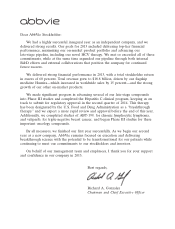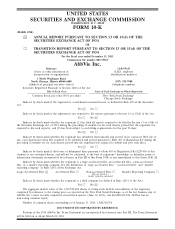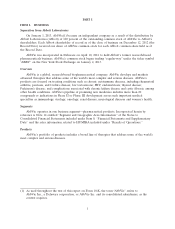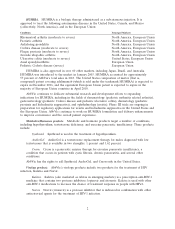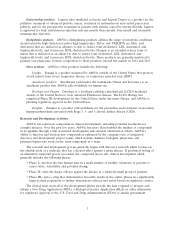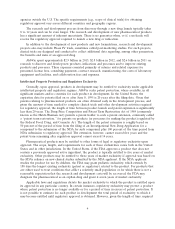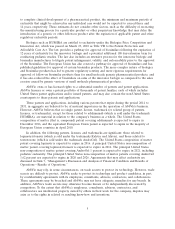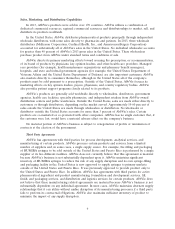AbbVie 2013 Annual Report Download - page 10
Download and view the complete annual report
Please find page 10 of the 2013 AbbVie annual report below. You can navigate through the pages in the report by either clicking on the pages listed below, or by using the keyword search tool below to find specific information within the annual report.Sales, Marketing, and Distribution Capabilities
In 2013, AbbVie’s products were sold in over 170 countries. AbbVie utilizes a combination of
dedicated commercial resources, regional commercial resources and distributorships to market, sell, and
distribute its products worldwide.
In the United States, AbbVie distributes pharmaceutical products principally through independent
wholesale distributors, with some sales directly to pharmacies and patients. In 2013, three wholesale
distributors (McKesson Corporation, Cardinal Health, Inc., and AmerisourceBergen Corporation)
accounted for substantially all of AbbVie’s sales in the United States. No individual wholesaler accounts
for greater than 40 percent of AbbVie’s 2013 gross sales in the United States. These wholesalers
purchase product from AbbVie under standard terms and conditions of sale.
AbbVie directs its primary marketing efforts toward securing the prescription, or recommendation,
of its brand of products by physicians, key opinion leaders, and other health care providers. Managed
care providers (for example, health maintenance organizations and pharmacy benefit managers),
hospitals, and state and federal government agencies (for example, the United States Department of
Veterans Affairs and the United States Department of Defense) are also important customers. AbbVie
also markets directly to consumers themselves, although in the United States all of the company’s
products must be sold pursuant to a prescription. Outside of the United States, AbbVie focuses its
marketing efforts on key opinion leaders, payors, physicians, and country regulatory bodies. AbbVie
also provides patient support programs closely related to its products.
AbbVie’s products are generally sold worldwide directly to wholesalers, distributors, government
agencies, health care facilities, specialty pharmacies, and independent retailers from AbbVie-owned
distribution centers and public warehouses. Outside the United States, sales are made either directly to
customers or through distributors, depending on the market served. Approximately 55-60 percent of
sales outside the United States are made through wholesalers or distributors. No wholesaler or
distributor outside the United States accounts for more than 3 percent of AbbVie’s sales. Certain
products are co-marketed or co-promoted with other companies. AbbVie has no single customer that, if
the customer were lost, would have a material adverse effect on the company’s business.
No material portion of AbbVie’s business is subject to renegotiation of profits or termination of
contracts at the election of the government.
Third Party Agreements
AbbVie has agreements with third parties for process development, analytical services, and
manufacturing of certain products. AbbVie procures certain products and services from a limited
number of suppliers and, in some cases, a single supply source. For example, the filling and packaging
of HUMIRA syringes to be sold outside of the United States and Puerto Rico is performed by a single
supplier at its two different facilities. AbbVie does not currently believe that this agreement is material
because AbbVie’s business is not substantially dependent upon it. AbbVie maintains significant
inventory of HUMIRA syringes to reduce the risk of any supply disruption and its own syringe-filling
and packaging facility in the United States is now approved to supply syringes to primary markets
outside of the United States and Puerto Rico. It was previously approved to provide product only to
the United States and Puerto Rico. In addition, AbbVie has agreements with third parties for active
pharmaceutical ingredient and product manufacturing, formulation and development services, fill,
finish, and packaging services, and distribution and logistics services for certain products. AbbVie does
not believe that these manufacturing related agreements are material because AbbVie’s business is not
substantially dependent on any individual agreement. In most cases, AbbVie maintains alternate supply
relationships that it can utilize without undue disruption of its manufacturing processes if a third party
fails to perform its contractual obligations. AbbVie also maintains sufficient inventory of product to
minimize the impact of any supply disruption.
6



